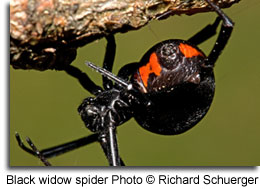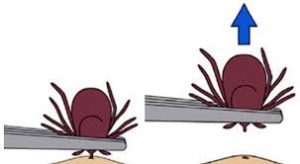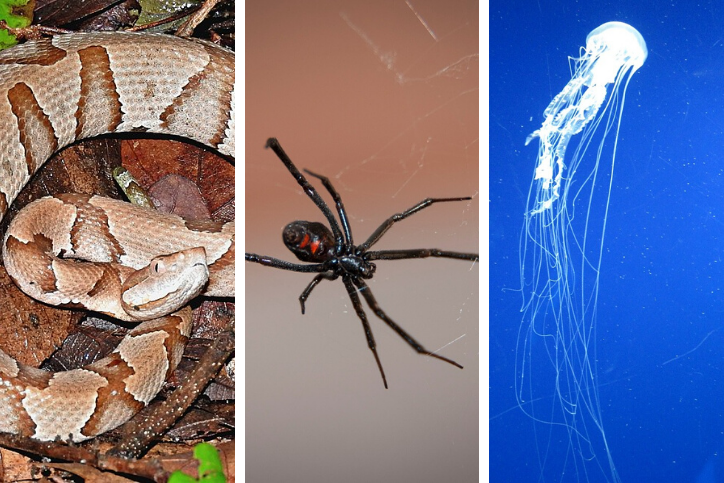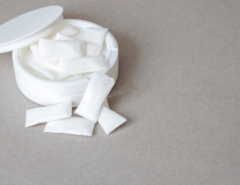If you’ve ever hiked in the state parks, visited a local walking trail, or just taken time to explore your backyard, you know that Maryland is full of native wildlife. Although most critters in Maryland are beneficial to the ecosystem, some can bite or sting humans, potentially causing an injury. Below, we take a closer look at some of the critters we frequently get calls about at the Maryland Poison Center (MPC).
Snakes
There are more than 20 snake species found in Maryland. All of them can bite, but only two are venomous and pose a danger to humans: the timber rattlesnake and the eastern copperhead. Both belong to the pit viper sub-family. You can tell pit vipers apart from other snakes by their triangle-shaped heads, oval-shaped pupils, and pits between the nose and eyes.
Not all bites from venomous snakes result in the injection of venom into the body. These snakes can bite as a warning without delivering venom. Symptoms to watch for around the bite site include pain, redness, and swelling that increases over time. While the pain and swelling can be significant, bites from the timber rattlesnake and eastern copperhead are rarely deadly.
You can prevent snake bites by wearing closed toe shoes and staying on the path when walking or hiking in the woods. When gardening, rustle plants with a garden tool before reaching your hand into an overgrown area. Finally, never try to pick up a snake. For more information about these snakes, visit the Maryland Department of Natural Resources’ page on venomous snakes.
Snake Bite First Aid
First and most importantly: remain calm. If possible, wash the area well with warm soapy water. If you are hiking, make your way to your car. Next, call the MPC before performing any additional first aid. Poison specialists can help assess the need for medical care. Never cut the bite site to suck out the venom. Do not use a tourniquet or ice, as this will cause the venom to concentrate in one area, potentially worsening the symptoms.

Photo Credit: Maryland Department of Natural Resources
Spiders
The black widow spider is the only venomous spider native to Maryland that poses a threat to humans. You can tell it apart from other spiders by its round, shiny black body and the orange-red hourglass on the underside of its abdomen. Black widows are shy, not aggressive, and hide in cool, dark places. Its bite may be painless or painful with redness and warmth at the site. Common symptoms include muscle pain and cramps that develop within two hours of the bite. The muscle pain usually appears in larger muscles near the bite site. For example, if bitten on the finger, the muscle pain might be felt in the arm or even the abdomen. While the muscle pain may be severe, the bite of a black widow is not deadly.
While the brown recluse spider is also venomous, it is not native to Maryland. Insect and spider bites that have become infected are often mistake for a brown recluse bite.
Most spiders bite humans as an act of self-defense. Often bites will become infected, leading to wounds that require medical care. Again, only the black widow poses a venomous injury to humans.
For more information, visit the Maryland Department of Natural Resources’ page on spiders.
Spider Bite First Aid
Wash the area well with warm soapy water. Always call the MPC before performing any additional first aid.

Ticks
There are six kinds of ticks in Maryland that are known to bite humans. Bites from some ticks found in Maryland may result in illnesses such as Rocky Mountain spotted fever or Lyme disease. The symptoms of both illnesses begin a few days to a few weeks following the tick bite and include headache, chills, fever, and a rash. Tick bites sometimes go unnoticed. Deer ticks are extremely small — about the size of a period in a newspaper.
You can prevent tick bites by wearing long sleeves and long pants when hiking. Change your clothes and shower immediately after returning from your hike. Safely applying insect repellents also decreases the risk of tick bites. To learn more about the safe use of insect repellent, you can download the MPC’s insect repellent information sheet here.
If you have found a tick on you or your loved one, you can follow these instructions from the University of Maryland to help identify it. If you want to have a tick tested to determine if it is carrying a tick-borne disease, the University of Massachusetts, Amherst can do so for a fee at this website.
Tick First Aid
Remove ticks using tweezers. Grasp the tick with the tweezers close to the skin and pull upward with steady, even pressure. Make sure entire tick has been removed. Wash the area thoroughly. Make a note of what day you removed the tick on a calendar or notepad. This will be helpful if you begin to have symptoms a short time later. If symptoms develop, contact a doctor.

Bees, Wasps, and Hornets
Bees, wasps, and hornets commonly sting when their nests are disturbed or if they get hit. Unless you have an allergy, one sting from a bee, wasp, or hornet won’t cause any harm, but it will be painful. If you are stung multiple times, there is a chance that the stings might cause more harm.
For more information, explore the University of Maryland Extension’s wasps and bees publication.
Bee, Wasp, and Hornet Sting First Aid
After being stung, look at the area to see if the stinger was left in the skin. If it is still in the skin, use tweezers to remove it as soon as you can to avoid further irritation. Wash the area with soap and water. Swelling and itchiness may occur around the site of the sting. Mild symptoms can be managed by calling the MPC. Symptoms that indicate an allergic reaction to the sting, including dizziness, nausea, and difficulty breathing within one hour of being stung, require immediate medical attention.
Jellyfish
There are a few types of jellyfish that are commonly found in the Chesapeake Bay and mid-Atlantic waters. Because of the murky color of the water, jellyfish are very hard to see while swimming. Stings from jellyfish found off the shores of Maryland typically produce mild symptoms. Occasionally, Portuguese Man O’ War will make their way to Maryland waters. Remember that even jellyfish that have washed up on the beach still have venom in their stingers. Avoid touching them with your hands.
Jellyfish Sting First Aid
If you are stung by a jellyfish, rinse the area with salt water. Vinegar can stop the venom in the stingers. Avoid using ammonia, rubbing alcohol, fresh water, or ice, because these may trigger the release of more venom. Scrape the stingers off using a credit card or by rubbing wet sand on the area.
For a printable information sheet about the above information, download our Bites and Stings information sheet.
If you or someone you know has been bitten or stung by one of these critters, follow the above first aid tips and call the MPC for more instructions. Calling the poison center is free and confidential; our poison experts are here to help 24/7/365.





Leave a Reply